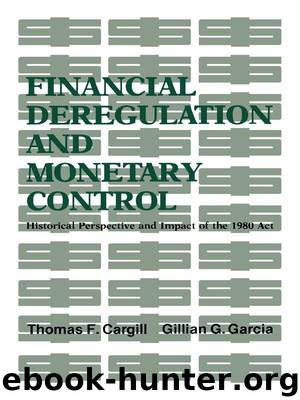Financial Deregulation and Monetary Control: Historical Perspective and Impact of the 1980 Act by Thomas F. Cargill

Author:Thomas F. Cargill [Cargill, Thomas F.]
Language: eng
Format: epub
Publisher: Hoover Institution Press
Published: 0101-01-01T00:00:00+00:00
THE NEW MONETARY POLICY
The policy failures of the mid and late 1970s led the Federal Reserve to the repeated and seemingly uncoordinated emergency actions of November 1978, October 1979, and March 1980.8 These measures also failed. The failures, together with the mounting criticism of Federal Reserve performance both at home and abroad, led the Board to revise its operating procedures in October 1979. Henceforth, the Board would use the quantity of reserves rather than the federal funds rate as the instrument of policy. This announcement marked the initiation of a three-pronged attack on the monetary-policy problem. It was followed, in February 1980, by the redefinition of the monetary aggregates, and in the following month by the omnibus act.
Using the monetary base as the policy instrument avoids the problem of estimating the anticipated inflation rate at the tactical stage of policymaking. Furthermore, it is hoped that the variability in the relationship between reserves and the stock of money will be less than that between the federal funds rate and the stock of money. If quantity of money were also used as the intermediate target, the problem of under-setting the interest rate could also be avoided at the strategic level. Analysts had hoped, therefore, that the Federal Reserve would jettison interest rates as the operating target and use instead a stochastic Quantity Theory relationship to describe the connection between money and GNP. Such a change would also reduce the number of links in the Federal Reserve's policy chain, since policy would then run from the monetary base to the stock of money, and then directly to GNP.
These relationships would, of course, be subject to variability. For example, in Figure 5 setting the monetary base at B* could produce money stocks in the range M1 to M2. Money stocks in this interval could result in GNP levels ranging between Y1 and Y2. In this representation, the potential variability in GNP has been substantially reduced from that observed in Figure 4. Whether this improvement would be found in the practical conduct of policy will not be known unless the Federal Reserve adopts the approach and relinquishes use of the short-term interest rate as its intermediate target. At present, as recent statements to the press indicate, the Board continues to pay attention to interest rates at the strategic level.
Download
This site does not store any files on its server. We only index and link to content provided by other sites. Please contact the content providers to delete copyright contents if any and email us, we'll remove relevant links or contents immediately.
Pale Blue Dot by Carl Sagan(4917)
The Rules Do Not Apply by Ariel Levy(4866)
Goodbye Paradise(3729)
Ogilvy on Advertising by David Ogilvy(3517)
Liar's Poker by Michael Lewis(3372)
Delivering Happiness by Tony Hsieh(3369)
Into Thin Air by Jon Krakauer(3314)
Purple Cow by Seth Godin(3143)
Rogue Trader by Leeson Nick(2980)
The Social Psychology of Inequality by Unknown(2941)
The Airbnb Story by Leigh Gallagher(2800)
4 - Harry Potter and the Goblet of Fire by J.K. Rowling(2657)
The Mind Map Book by Tony Buzan(2514)
Bossypants by Tina Fey(2471)
Claridge's: The Cookbook by Nail Martyn & Erickson Meredith(2359)
All the President's Men by Carl Bernstein & Bob Woodward(2332)
Six Billion Shoppers by Porter Erisman(2268)
Master of the Game by Sidney Sheldon(2244)
Alibaba by Duncan Clark(2040)
